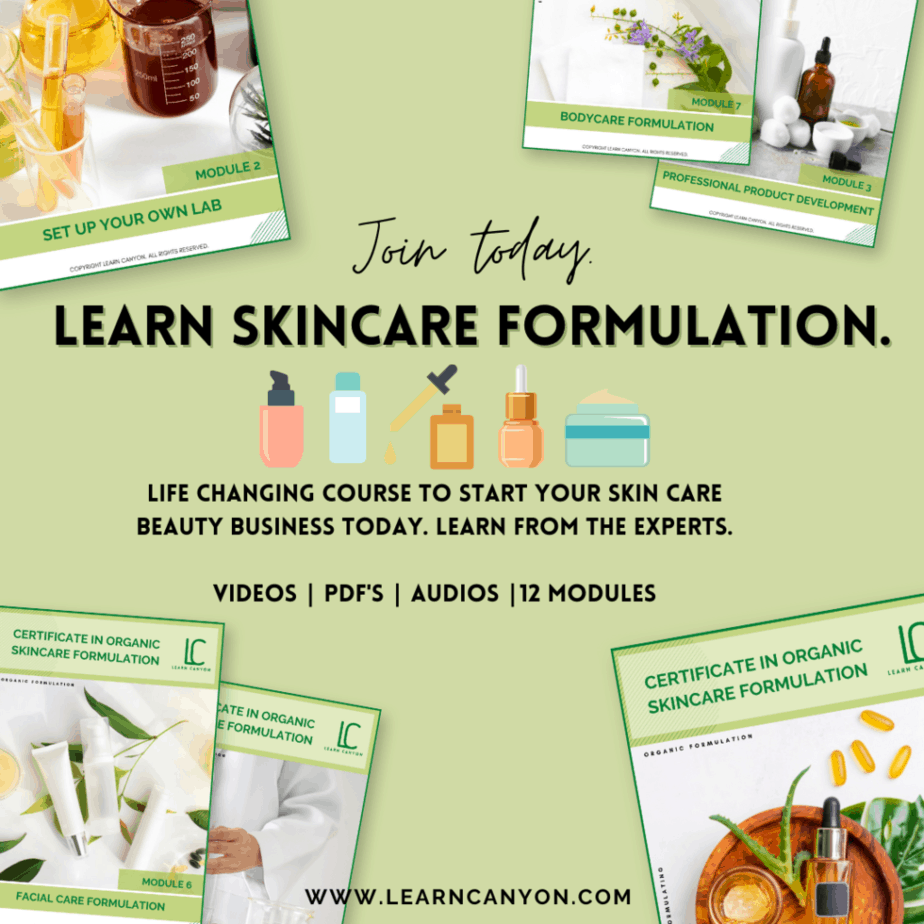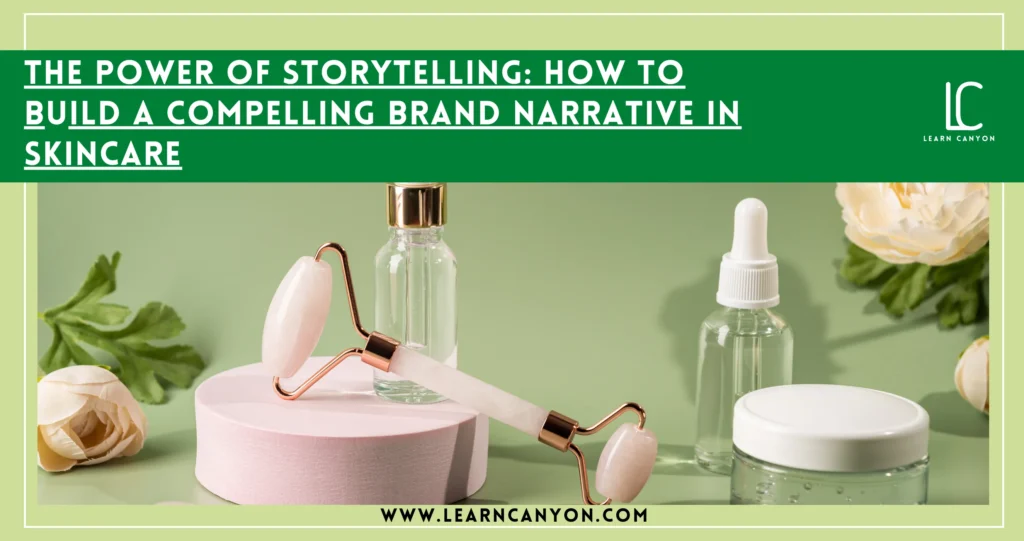People will only know what they are looking for in cosmetic stores once they are drawn to a particular skincare brand that highlights something to be curious about.
And what’s that?
What drew you to a skincare brand when you first saw it? – Brand Narrative for Skincare
For sure, It gave the assurance that glowing skin and dazzling attractiveness are appealing, but what truly catches our attention and leaves an indelible mark?
The stories behind the items are the narratives that appeal to our emotions and ideals and make us feel like we’re a part of something larger.
In the competitive skincare world, having a compelling brand narrative can set your products apart from the rest. The power of storytelling is a valuable tool for creating a connection with your audience and building brand loyalty. Skincare brands can establish a unique identity and stand out in a crowded market by crafting a narrative that resonates with consumers.
A strong brand narrative in skin care can help communicate the values, mission, and unique selling points of a brand. It can also create an emotional connection with consumers, making them more likely to engage with the brand and become loyal customers.
In this article, we will explore the importance of storytelling in skincare branding and provide practical tips for building a compelling brand narrative that resonates with your target audience.
Understanding the Power of Storytelling in Branding
First of all, we need to have precise clarity on the power of storytelling in branding, business, marketing, advertising or general human connection.
Why are stories powerful in brand narrative?
- Storytelling engages readers’ imagination.
- Stories extend beyond facts and beliefs.
- Stories evoke emotions and the senses.
- Stories are communicative – they encourage people to react and share their own stories.
- Stories offer hooks for people to latch onto in your blogging (since they are relatable).
- Stories catch and hold readers’ attention.
- While people do not necessarily grasp facts and data, a good tale can be remembered for years.
- Stories demonstrate your views in ways that can be far more convincing than other sorts of information.
Brand Storytelling creates an emotional bond with the audience through several mechanisms:
- Relatability and Identification
- Shared Experiences: When a story reflects experiences or emotions that the audience has encountered, it fosters a sense of connection and understanding.
- Character Identification: Well-developed characters allow the audience to see themselves in the story, making them care about the outcomes and experiences of these characters.
- Emotional Engagement
- Evoking Emotions: Stories can evoke a wide range of emotions such as joy, sadness, fear, and excitement, making the audience feel a deeper connection.
- Emotional Investment: As the audience becomes emotionally invested in the story, they are likelier to engage with and remember the content.
- Authenticity and Trust
- Honesty and Transparency: Authentic stories that reflect real values and truths build trust with the audience.
- Vulnerability: Sharing struggles, failures, and genuine emotions makes the brand or storyteller appear more human and relatable.
- Psychological Mechanisms
- Mirror Neurons: When people hear a story, their brains often simulate the characters’ experiences, creating empathy and emotional engagement.
- Narrative Transportation: The process of being absorbed into a story, known as narrative transportation, leads to a stronger emotional connection and influence on beliefs and attitudes.
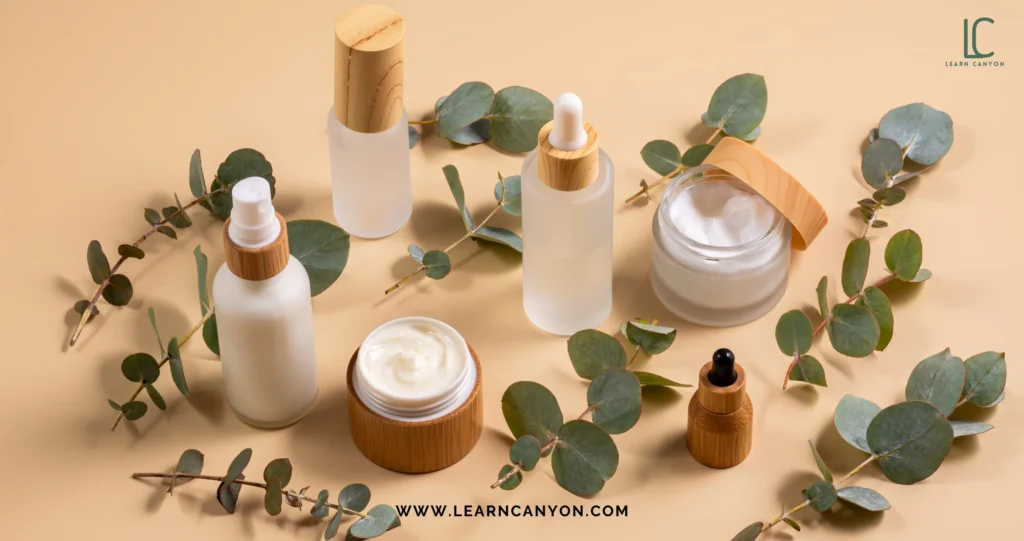
Compelling Narrative Sets a Skincare Brand Apart From Competitors
Here’s how;
- Building Unique Brand Identity In Skincare
- Distinctive Story: A unique narrative can highlight the brand’s origins, mission, and values, differentiating it from others in the market.
- Personal Connection: Stories that reflect the founder’s journey, challenges, and inspirations make the brand more relatable and memorable.
- Creating Emotional Engagement
- Emotional Resonance: A compelling narrative that taps into the audience’s emotions can create a strong emotional connection, fostering brand loyalty.
- Authentic Experiences: Sharing genuine customer stories and testimonials can evoke trust and empathy, enhancing the brand’s credibility.
- Highlighting Benefits and Values
- Clear Messaging: A well-crafted narrative can effectively communicate skincare products’ unique benefits and value propositions, making them stand out.
- Value-Driven Marketing: Emphasizing the brand’s commitment to sustainability, cruelty-free practices, or natural ingredients can attract customers who share those values.
- Enhancing Brand Perception
- Storytelling Quality: High-quality storytelling reflects the brand’s professionalism and attention to detail, positively influencing how customers perceive the brand.
- Cultural and Social Relevance: Narratives that align with current cultural or social trends can make the brand more relevant and appealing to contemporary consumers.
- Fostering Community and Belonging
- Community Building: A narrative that encourages customer participation and interaction can create a sense of community and belonging among the brand’s audience.
- Shared Identity: Stories that reflect the values and aspirations of the target audience help in building a loyal customer base with a shared identity.
- Enhancing Recall and Recognition
- Memorable Stories: Compelling narratives are easier to remember, helping the brand to stay top-of-mind for customers.
- Consistent Brand Image: A consistent story across all marketing channels strengthens brand recognition and reinforces the brand image.
- Driving Customer Loyalty and Advocacy
- Emotional Loyalty: Customers who feel emotionally connected to a brand are more likely to remain loyal and make repeat purchases.
- Brand Advocates: Satisfied customers who resonate with the brand’s narrative are more likely to become brand advocates, sharing their positive experiences with others.
Key Elements to Brand Narrative for Skincare
There are certain key elements to create a skincare brand narrative to create a unique brand identity in skincare;
1. Authenticity
- The narrative should be real and truthful, reflecting the skincare brand’s origins, values, and mission.
- Openly share the skincare brand’s journey, including challenges and successes, to build trust.
2. Relatability
- Create a story that resonates with the target audience’s experiences, needs, and aspirations.
- Show understanding and compassion for the audience’s skincare concerns and desires.
3. Consistency
- Ensure the narrative is consistent across all platforms and touchpoints, from social media to packaging.
- Maintain a consistent tone and style that aligns with the skincare brand’s personality.
4. Mission and Values
- Communicate the skincare brand’s mission, vision, and core values.
- Highlight how the skincare brand’s products and actions reflect these principles.
5. Unique Selling Proposition (USP)
- Clearly articulate what sets the skincare brand items apart from competitors.
- Showcase the unique ingredients, cosmetic formulations, or technologies used.
6. Emotional Engagement
- Use compelling characters, conflict, and resolution to evoke emotions.
- Share real stories from satisfied customers to create emotional connections.
7. Visual Storytelling
- Use high-quality images and videos that reflect the cosmetic brand’s narrative.
- Ensure that the visual elements, such as packaging and website design, align with the story.
8. Cultural and Social Relevance
- Connect the skincare brand narrative to current cultural or social trends and issues.
- Show the cosmetic brand’s involvement in relevant social causes or community activities.
9. Product Journey
- Share the process of product development, from sourcing ingredients to final production.
- Highlight sustainable practices in sourcing, production, and packaging.
10. Customer Engagement In Beauty Industry
- Encourage customers to share their own stories and experiences with the brand.
- Feature content created by customers to enhance authenticity and community feel.
NOTE: Customer engagement in beauty industry is crucial for building brand loyalty, increasing sales, and creating a community of devoted customers. Elements that can enhance customer engagement in this sector are personalized experiences such as custom product recommendations, virtual try-ons, tutorial videos, live-streaming, social media challenges, customer reviews and testimonials, community building, VIP access, In-store events, surveys and polls, content marketing, email newsletters, mobile apps, chatbots, and customer-centric culture.
Examples of Successful Customer Engagement in Beauty Industry
- Sephora: Offers a comprehensive loyalty program, Beauty Insider, which provides personalized rewards, exclusive access to events, and tailored product recommendations.
- Glossier: Actively engages with customers on social media, featuring user-generated content, and involving their community in product development decisions.
- L’Oréal: Uses AR technology for virtual try-ons and AI chatbots to offer personalized product advice and enhance the online shopping experience.
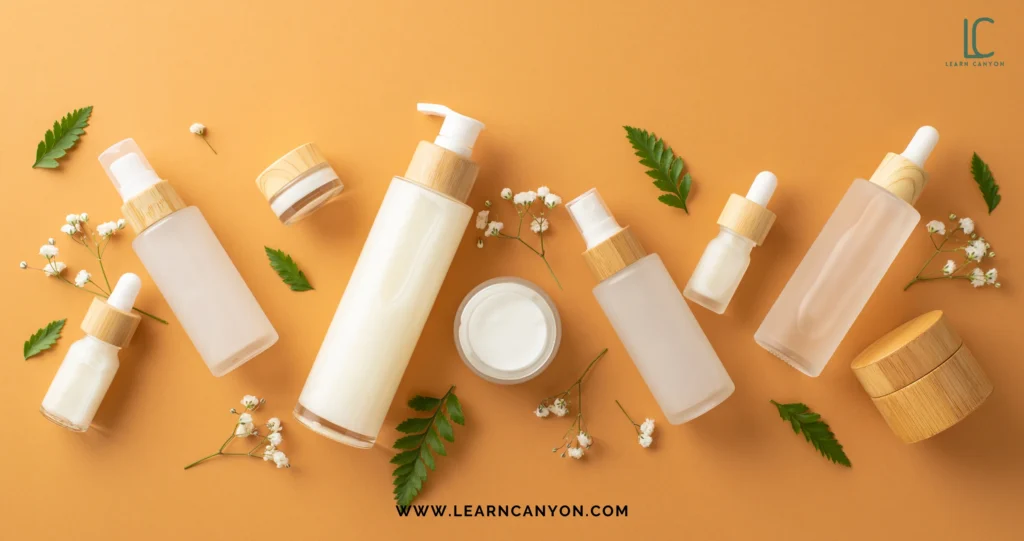
Steps To Build A Successful Skincare Brand Narrative
1. Identify Your Brand’s Core Story
- Foundational Elements: Start by defining the origins of your brand. Ask questions like: Why was the brand created? What inspired its inception? What gaps in the market does it aim to fill?
- Brand Vision: Outline the long-term vision and mission of your brand. What are your goals? What impact do you want to have on the industry and your customers?
- Unique Selling Proposition (USP): Clearly articulate what makes your brand unique. This could be innovative ingredients, sustainable practices, or exceptional product efficacy.
2. Understand Your Target Audience
- Market Research: Conduct thorough research to understand the demographics, preferences, and needs of your target audience.
- Customer Personas: Develop detailed customer personas that represent your ideal customers. Include information such as age, gender, skincare concerns, lifestyle, and purchasing behaviour.
- Pain Points and Aspirations: Identify the key skincare issues and aspirations of your audience to tailor your narrative to their needs and desires.
3. Develop Your Brand Persona
- Brand Personality: Define the personality of your brand. Is it luxurious and sophisticated, friendly and approachable, or innovative and cutting-edge?
- Tone and Voice: Determine the tone and voice of your brand’s communication. Ensure it aligns with the brand personality and resonates with your target audience.
- Visual Identity: Create a visual identity that complements your brand persona. This includes your logo, colour palette, typography, and overall design aesthetic.
4. Craft Your Brand Message
- Core Message: Develop a clear and concise core message that communicates the essence of your brand. This message should reflect your brand’s mission, vision, and USP.
- Supporting Messages: Create additional supporting messages that expand on your core message. These should address specific aspects such as product benefits, brand values, and customer benefits.
- Story Elements: Incorporate elements of storytelling such as characters (founders, customers), conflict (skincare challenges), and resolution (how your products provide solutions).
5. Visual Storytelling
- High-Quality Imagery: Use high-quality images that reflect your brand’s aesthetics and values. This includes product photography, lifestyle shots, and behind-the-scenes content.
- Video Content: Create engaging video content that tells your brand story, showcases product usage, and features customer testimonials.
- Consistent Design: Ensure that all visual elements are consistent across your website, social media, packaging, and marketing materials.
6. Integrate Your Narrative Across All Channels
- Website: Your website should communicate your brand story, from the About Us page to product descriptions. Use storytelling techniques to engage visitors.
- Social Media: Share your brand story through posts, stories, and live videos on social media platforms. Encourage user-generated content and customer interaction.
- Content Marketing: Use blogs, articles, and email newsletters to delve deeper into your brand narrative. Share stories about your products, behind-the-scenes processes, and customer experiences.
- Product Packaging: Reflect your brand story in your packaging design. Include elements such as storytelling text, brand values, and visual motifs that align with your narrative.
7. Engage with Your Community
- Customer Interaction: Actively engage with your customers through social media comments, messages, and reviews. Show appreciation for their support and feedback.
- Events and Campaigns: Host events and campaigns that involve your customers in your brand story. This could include product launches, giveaways, and interactive Q&A sessions.
- User-Generated Content: Encourage customers to share their own stories and experiences with your products. Feature this content on your website and social media to build a sense of community.
8. Evolve Your Narrative
- Continuous Improvement: Regularly assess and update your brand narrative to keep it relevant and engaging. Take into account new trends, customer feedback, and industry developments.
- Adaptability: Be open to evolving your story as your brand grows and changes. Ensure that your narrative remains authentic and aligned with your core values and mission.
Storytelling Techniques for Successful Skincare Marketing
Storytelling is a powerful tool in skincare marketing. It can connect with customers on an emotional level, convey the brand’s values, and differentiate products in a crowded market.
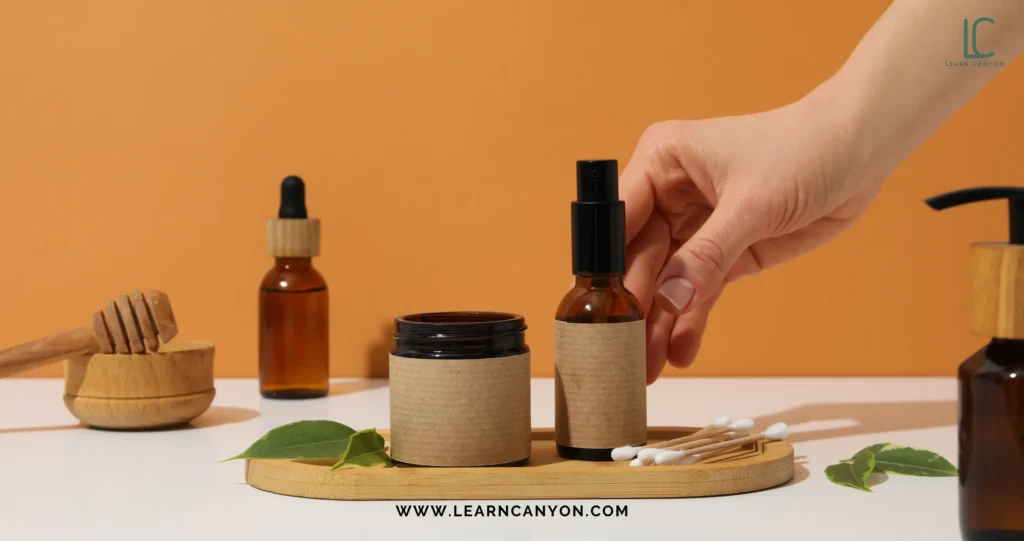
Here are some effective storytelling techniques for successful skincare marketing:
1. Customer Stories and Testimonials
- Real-Life Testimonials: Share stories from real customers who have benefited from the brand’s products. This creates authenticity and trust.
- Before and After Stories: Showcase the transformation customers experience using the product with before and after photos and stories.
2. Skincare Brand Story
- Founder’s Story: Share how the particular skincare brand was founded, the inspiration behind it, and the passion driving it.
- Brand Values and Mission: Highlight the brand’s commitment to sustainability, cruelty-free practices, or other core values to connect with like-minded consumers.
3. Educational Content
- Skin Health Tips: Provide valuable information about skincare routines, the importance of certain ingredients, and how to address specific skin concerns.
- Ingredient Stories: Dive into the origin, benefits, and science behind key ingredients used in the products.
4. Problem-Solution Narratives
- Common Skin Issues: Identify common skin problems and narrate how the products effectively solve these issues.
- Step-by-Step Solutions: Offer detailed guides on how to use the skincare products to achieve desired results.
5. User-Generated Content
- Social Media Shares: Encourage customers to share their experiences and tag the brand, then feature this content on official channels.
- Community Building: Create a sense of community where users feel part of a larger movement or lifestyle.
6. Emotional Connection
- Personal Stories: Share relatable brand stories that evoke emotions, whether it’s about confidence, self-love, or overcoming challenges.
- Visual Storytelling: Use high-quality images and videos to tell stories visually, making the content more engaging and impactful.
7. Seasonal and Topical Stories
- Seasonal Skincare Tips: Tailor content to address skincare needs for different seasons or weather changes.
- Topical Events: Align stories with current events or popular topics, such as skin care for virtual meetings or mask-related skin issues.
8. Interactive Stories
- Quizzes and Polls: Engage customers with interactive content that helps them find the best products for their skin type or concerns.
- Live Sessions: Host live Q&A sessions, product demos, or skincare tutorials to interact directly with the audience.
9. Success Stories
- Influencers and Experts: Collaborate with online influencers and skincare experts to share their success stories with the products.
- Case Studies: Present detailed case studies of how the products have helped individuals with specific skin concerns.
10. Ethical and Sustainable Practices
- Sustainability Efforts: Share the skincare brand’s efforts towards sustainable packaging, ethical sourcing of ingredients, and environmental impact.
- Cruelty-Free Commitment: Highlight the commitment to cruelty-free testing and production processes.
Examples of effective storytelling in skincare branding
Here are some notable examples of effective storytelling in skincare branding:
1. Glossier
- Community-Driven Content: Glossier has built a strong community by encouraging customers to share their skincare routines and experiences on social media. This user-generated content is then featured on Glossier’s official channels, creating a sense of authenticity and belonging.
- Founder’s Story: Emily Weiss, the founder of Glossier, shares her journey from beauty blogger to brand founder, emphasizing her commitment to listening to real customer needs and preferences.
2. The Ordinary
- Educational Approach: The Ordinary focuses on demystifying skincare by explaining the science behind each ingredient in a straightforward and accessible manner. This educational content helps consumers make informed choices and builds trust in the brand’s transparency.
- Minimalistic Branding: Their storytelling is reflected in their minimalistic product design and straightforward naming conventions, emphasizing simplicity and effectiveness.
3. Drunk Elephant
- Founder’s Philosophy: Tiffany Masterson, the founder of Drunk Elephant, shares her personal skincare struggles and her journey to create biocompatible skincare products free of the “Suspicious 6” ingredients. This personal touch resonates with customers looking for safe and effective solutions.
- Ingredient Transparency: The brand educates consumers on the benefits of each ingredient and why certain harmful ingredients are excluded, reinforcing their commitment to skin health and safety.
4. Biossance
- Sustainability and Ethics: Biossance focuses on sustainable beauty by using renewable sugarcane-derived squalane in their products. Their storytelling emphasizes their commitment to the environment and ethical sourcing, appealing to eco-conscious consumers.
- Impact Stories: Sharing stories of their positive impact on the environment and the communities they source from helps create an emotional connection with customers who value sustainability.
5. Herbivore Botanicals
- Natural and Simple: Herbivore Botanicals focuses on natural ingredients and simple, effective formulations. Their storytelling highlights the purity and simplicity of their products, appealing to those looking for clean and natural skincare.
- Visual Storytelling: The brand uses aesthetically pleasing visuals and minimalist design to tell its story of natural beauty and wellness.
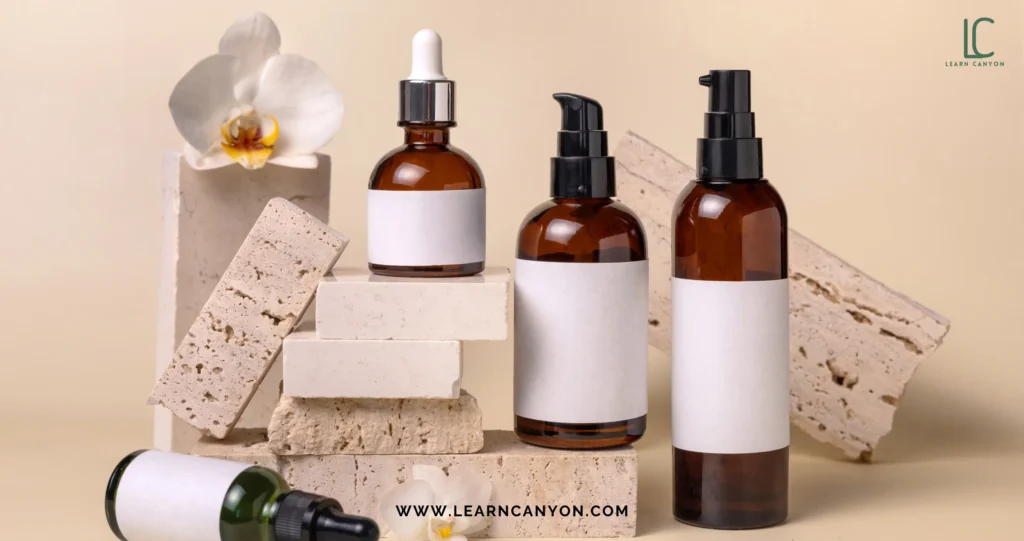
Using Brand Storytelling In Social Media Campaigns
Incorporating storytelling into social media campaigns is an effective way to engage with your audience, build brand loyalty, and convey your brand’s values and mission.
Here’s how to integrate storytelling into your social media strategy:
- Plan Your Content Themes
- Founder’s Journey: Share the story of how your brand started, the challenges faced, and the vision behind it.
- Customer Success Stories: Highlight testimonials and experiences from satisfied customers. Use before-and-after stories to show product impact.
- Behind-the-scenes: Show the process of how your skincare products are made, including ingredient sourcing, manufacturing, and quality control.
- Educational Content: Share informative content about your products, skincare routines, and ingredient benefits.
2. Create a Content Calendar
- Consistent Posting: Plan a regular posting schedule to keep your audience engaged.
- Story Arcs: Develop story arcs that unfold over multiple posts, keeping your audience coming back for more.
3. Use Visual Storytelling
- High-Quality Imagery: Use professional photos and videos to create visually appealing content.
- Infographics: Simplify complex information into easy-to-understand infographics.
- Videos: Create engaging skincare videos such as tutorials, testimonials, and behind-the-scenes footage.
4. Leverage User-Generated Content (UGC)
- Branded Hashtags: Encourage customers to share their stories using a branded hashtag.
- Reposting: Feature user-generated content on your official social media pages to build community and authenticity.
5. Engage with Your Audience
- Interactive Content: Use polls, quizzes, and Q&A sessions to engage your followers and make them feel part of the story.
- Live Videos: Host live sessions to interact directly with your audience, share updates, and answer questions in real time.
6. Collaborate with Influencers
- Influencer Partnerships: Work with influencers who align with your brand values to share your story and products with their followers.
- Storytelling Campaigns: Develop campaigns where influencers share personal stories related to your brand or products.
7. Utilize Instagram Stories and Reels
- Behind-the-Scenes Snippets: Use Instagram Stories to give a peek behind the scenes of your brand operations.
- Customer Features: Share customer testimonials and stories in your Stories and Reels.
- Educational Tips: Provide quick skincare tips, product usage guides, and ingredient highlights.
8. Run Contests and Giveaways
- Story-Based Contests: Encourage followers to share their stories related to your brand or products for a chance to win prizes.
- Engagement Boost: Use contests and giveaways to increase engagement and reach.
Wrapping Up,
Overall, the power of storytelling in skincare brand narrative marketing lies in its ability to humanize the brand, making it more than just a provider of products but a companion in the customer’s skincare journey. By crafting a compelling brand narrative that authentically reflects its values, engages emotions, and builds a community, a skincare brand can differentiate itself in the market, build lasting relationships, and ultimately drive business success.
Incorporating storytelling to highlight your skincare brand is not a one-time effort but a continuous process of connecting with the audience, sharing meaningful stories, and evolving with the changing landscape. When done effectively, storytelling transforms a skincare brand from a name in the market to a beloved part of the customer’s daily life.
Here, at Learn Canyon, anyone can transform their skincare business profoundly as we help cosmetic entrepreneurs to elevate their brand on a whole new level. We help them to understand the particular skincare niche they want to start their line by offering them highly-skilled formulation techniques through our well-managed formulation courses to create skincare products in our advanced laboratories.
To know more about us, you can freely connect with us here.


